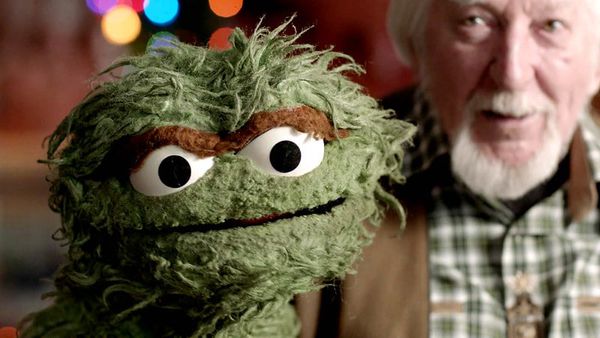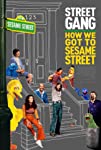Eye For Film >> Movies >> Street Gang: How We Got To Sesame Street (2021) Film Review
Street Gang: How We Got To Sesame Street
Reviewed by: Jennie Kermode

It’s difficult, outside the US, to understand just what its television landscape looked like in the Sixties and before. There were a handful of programmes aimed at children, such as Mr Rogers’ Neighborhood, but they weren’t relatable to kids from all backgrounds, and almost everything else available was first and foremost about pushing products. Early on in this documentary, one of its contributors describes Sesame Street as "What television would do if it loved people rather than trying to sell to people," and all of the magic comes from there.
Could television be socially useful? To Americans, this was a new idea. It began with Joan Ganz Cooney, who imagined a series which could prepare young children for school and help to close the literacy gap between kids from different backgrounds, improving the life chances of those from the inner cities and reducing the economic gap between Americans of different races. It was a hugely ambitious idea, especially coming from a woman at a point when the television industry was generally dismissive of women’s ability. What made it reality was the confluence of a number of remarkably talented individuals, including one whom she initially took for a hippy, wondering what he was doing in the room: Jim Henson.

Today the Muppets are commonly thought of as children’s entertainers, partly due to Sesame Street. A lot of people fail to take in the adult nature of their work, especially in the early days. Director Marilyn Agrelo sets the tone here by including some early adverts made by the Henson company which are little known today, which illustrate the dark humour associated with the brand. The sexuality it often involved is not mentioned (later, a discussion about the close friendship between Bert and Ernie will exclude any other interpretation of their relationship) but the film does feature a behind-the-scenes clip of Oscar the Grouch complaining that there wasn’t enough sex on Sesame Street.
Part of the ethos of the series right from the start was that it shouldn’t talk down to kids. This meant honesty about difficult subjects, most notable in the funeral held for much-loved character Mr Hooper when the actor who played him, Will Lee, died. Big Bird’s confusion about the finality of death provided an opportunity to help children make sense of it in a direct and straightforward but sensitive way. The series would also break new ground by showing a woman breast feeding, but by far the biggest controversy around it related toi its handling of racial integration. Setting it in the inner city was a bold move to begin with. The casual, unremarked mixing of people from different backgrounds was rare on US television, especially in children’s entertainment, and it had big consequences.
There’s a lot of great archive footage here from pivotal moments in the programme’s history. One of the gems features a representative of Mississippi Educational Television, asked why his organisation hasn’t picked it up and if this has anything to do with its integrated cast. He barely needs to speak in response. Before he opens his mouth, there’s a look in his eyes which says everything. But as every parent knows, children have a way of getting what they want, and eventually that resistance was broken down too.
Did Sesame Street always get it right? Agrelo examines the controversy around the introduction of Roosevelt Franklin, a brown character with fuzzy black hair who was meant to demonstrate more active inclusion to kids so used to white characters dominating television that they needed more than just bright coloured muppets to help them feel that this was a programme for them. Some black parents felt the character was a problematic stereotype and he was eventually dropped, which contributed to Matt Robinson deciding to leave the series. Every incident like this was obviously difficult for a close-knit team. Although it’s impossible to talk about everyone, the film features interviews with numerous surviving contributors (including Cooney herself) and dedicates a fair bit of time to exploring the relationships between them, from the comic partnerships which influenced writing and improvisation to footage of Big Bird singing at Jim Henson’s funeral.
That song, It’s Not Easy Being Green, was one of numerous great tunes created by a small music team with an incredibly demanding job. This is given its due not only in discussion but also in the songs played throughout the film. Songs about letters. Songs about numbers. Songs about aardvarks. Over the closing credits, a stonking number about the impossibility of playing the saxophone well whilst holding a duck at the same time. There’s humour here for adults. Research showed that children learned better when they were in the room too, we hear.
Whilst there’s relatively little on the series’ famous guests, we see footage of Dizzy Gillespie playing his trumpet and Johnny Cash bonding with Oscar the Grouch. There are also clips of the creative team on chat shows, sometimes accompanied by famous muppets like Kermit the Frog. Naturally Cookie Monster gets a few good moments, and there’s nary a mention here of his favourite snack being a sometimes food.
Amongst the contributors here are Jim Henson’s daughters, Polly and Kate, who made a few appearances in the series themselves. “It was a wonderful way to grow up, where I had all these friends who were blue and fuzzy,” Polly remembers. The kids were at the heart of everything. The wave of excitement from young fans across the country clearly exceeded the expectations of the programme’s creators by orders of magnitude. Street Gang captures some of that excitement. Its title speaks not just to the stories of cast and crew, but to US society. For all its mistakes over the decades, it sometimes got things wonderfully right, and Agrelo’s film reminds us what an enormous step it took to get to Sesame Street.
Reviewed on: 11 Dec 2021
















